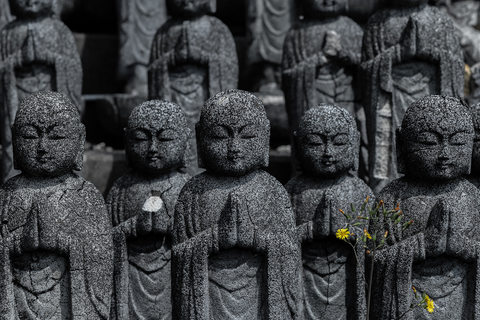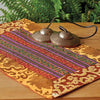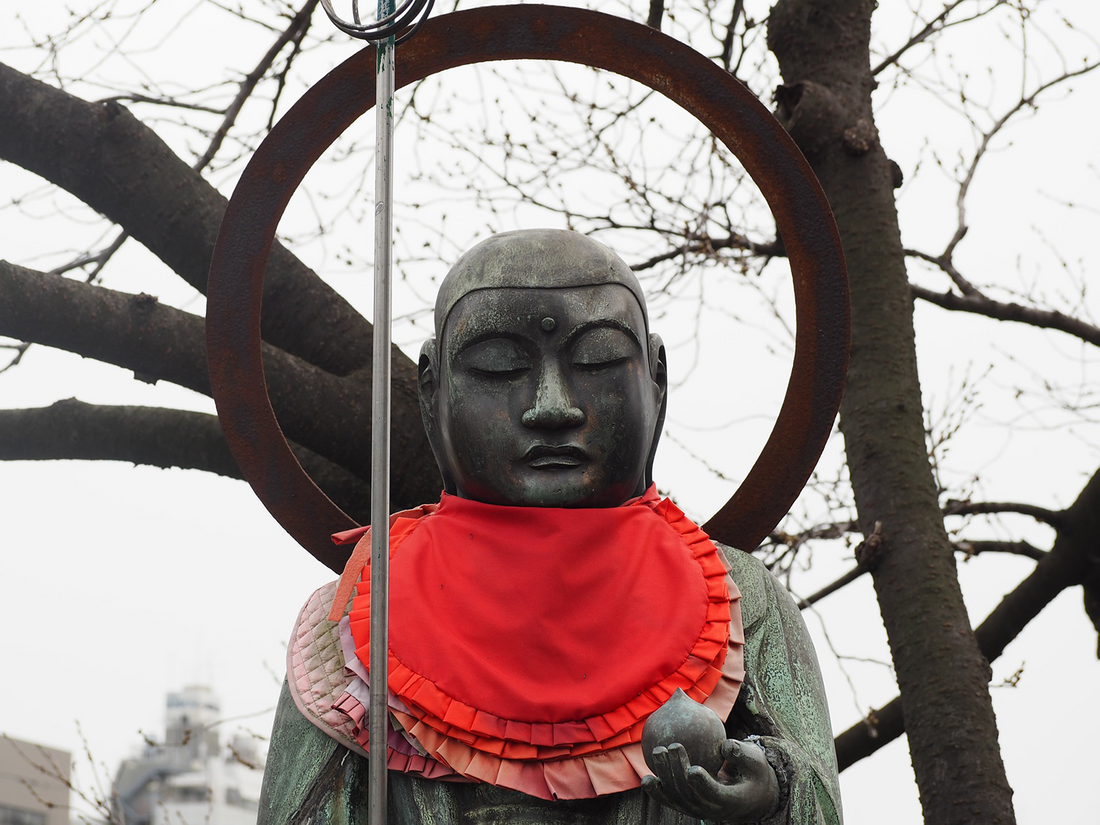Jizo, the cherub-faced bodhisattva in red, has come to occupy a space not unlike Hotei, the rotund god of happiness so many think of as the “laughing buddha”—images of both are everywhere, but with little cultural context to understand who they are or what they represent. When I lived in Japan, statues of Jizo were everywhere: temples, street corners, parks; images of Jizo appear on t-shirts, scarves, notebooks. Jizo belongs on anything meant to evoke cuteness or gentleness. But who is he?
The story I’ve heard is that long before the time of the Buddha, Jizo was a maiden named Sacred Girl, whose mother had died and gone to hell. Sacred Girl would sell off her possessions to make offerings to the Buddha (of that era) and pray for her mother’s salvation. Eventually, the Buddha helped her see into hell, where she could see that, thanks to her selfless prayers, her mother had made her way to heaven. But more importantly, she saw the suffering of those in hell and her heart broke open, setting the trajectory of that and future lives.
Over many lifetimes, she became Ksitigarbha (Jpn., Jizo), the “bodhisattva of the great vow.” Jizo has become the bodhisattva of choice for common folks and common concerns. He protects travelers; he’s also the guardian of the souls of miscarried, stillborn, and aborted babies. Folk tales about Jizo portray him as being helpful and a little mischievous, in the way that we might imagine elves sneaking in at night to make extra shoes for the poor cobbler. He’s magical—he’s also just really nice.

But what makes him the bodhisattva of the great vow is something more. Alone among bodhisattvas (or at least, that’s how I’ve heard it), he can move at will between the six realms of gods, demigods, humans, hungry ghosts, and hell-beings. Jizo can go to hell, and he does—his heart is still broken open by the plight of anyone who is stuck in that way, anyone who is so tortured, literally or metaphorically, that they can’t move. So Jizo goes to them. He soothes them, and he offers the teachings that might show them a glimpse of a way out.
I find this all so beautiful. Jizo can go anywhere he wants, so where does he go? To where the suffering is. The Korean Zen master Seung Sahn said, “Before you can save someone from hell, you have to go to hell.” For Jizo, suffering is not an abstraction—it isn’t something over there. Neither is his conception of suffering modeled solely on his own pain, which is as far as many of us ever go. He goes to where the suffering is, he witnesses it, studies it, immerses himself in it. He chooses to stay close.
What does that look like in your own life? The point of these bodhisattvas is not to be served or saved by them—it’s to bring them to life through our own actions. When we see Avalokiteshvara with a thousand arms, we reach out and help someone. When we see Manjushri with the sword that cuts through delusion, we offer up our own delusion, and our own sword appears in our hands. And when we see the gentle, unassuming figure of Jizo on a street corner or in a garden, we smile, and we bow, and then we ask ourselves: “Where do I need to go? What places am I avoiding? Who needs me there?”
As I mentioned earlier, Jizo protects travelers—he is one, after all. We can take up that same life. Someone, somewhere, is stuck where they are, so we notice that. We travel to them; we move a little closer, feel that person’s flames. This can be your superpower, too.

Author: Koun Franz
Koun Franz is a Montana-born Soto Zen priest who trained, taught, and translated in traditional monasteries in Japan. He is the guiding teacher of Zen Nova Scotia; his talks can be found on the ZNS Podcast.

Our benevolent bodhisattva will bestow blessings on your home and family. Jizo is the protector of women, children and travelers in the six realms of existence. Bonded stone with antique finish.
Bodhisattva Cuff, Sterling Silver
Sterling silver cuff inscribed with Shantideva's Prayer fits men, as well as women whose hands are a bit large for the mobius bracelet. The Wheel of the Dharma, a symbol for the teachings of the Buddha, adorns the top of the cuff, and Shantideva's Prayer is discreetly inscribed beneath. Handcrafted in the USA of fine, polished sterling silver

It is customary to place a beautiful textile under statues and ritual objects on your shrine to show honor and respect. These cotton altar cloths are woven in a traditional Bhutanese design called "Ghata" and trimmed in brocade.

This 8 foot Green Tara Prayer Flag Garland is beautifully made to add character in any meditation space. Continuing a Tibetan tradition of hanging cloth flags, this set is made by printing lucky signs, sacred symbols, and wishes for peace and prosperity, all on Lokta paper.


